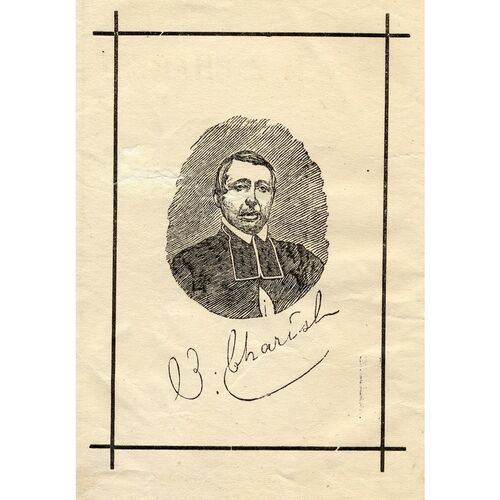CHAREST, ZÉPHIRIN, parish priest; b. 21 Feb. 1813 at Sainte-Anne-de-la-Pérade, L.C., son of Antoine Charest and Marie-Anne Marchand; d. 7 Dec. 1876 at Saint-Roch de Québec.
Zépharin Charest was born of well-to-do farmers, and was one of a large family; one brother was a doctor, and Bishop Louis-François Laflèche* was a relative. He was a pupil at the seminary of Nicolet, and, thanks to an outstanding memory, he was brilliantly successful. He completed his theological studies at Quebec, where on 11 Dec. 1836 he was ordained a priest. He was then appointed curate of Saint-Roch de Québec, and there he was to spend the remainder of his life. At the time of the events of 1837 and 1838, the parish of Saint-Roch was one of the most disturbed areas in the Quebec region. The parish priest and his curates were required, when called upon by the bishop, to preach against the revolutionary movement. On these occasions some of the inhabitants of the district even uttered threats against the priest and his curates. In 1839 Charest succeeded the parish priest David-Henri Têtu.
During the second third of the 19th century the Saint-Roch area developed with great rapidity; from less than 8,000 inhabitants in 1831 it went up to nearly 25,000 in 1871. Country dwellers who had come there to work at shipbuilding on the St Charles River were particularly numerous. Charest took an interest in the material as well as the spiritual condition of this population, whose way of life was crude and who had little education. Since the schools run by laymen were too few in the area [see Antoine Légaré], he appealed to the religious communities to lend a hand. In 1841, following the wish of Bishop Joseph-Octave Plessis*. he asked the sisters of the Congregation of Notre-Dame, who were already in residence in Lower Town, for their services. He had a spacious convent built in which the nuns went to live in 1844, and he made himself their chaplain. The convent of Saint-Roch, which took in boarders and day-pupils, was the object of his tender care and his favourite refuge. The sisters left to the parish priest the task of dealing with many material as well as spiritual questions. The convent had 1,000 pupils at the time of Charest’s death.
In 1852 the priest installed at Saint-Roch, in a school first called the École du Sacré-Cœur then the École Lagueux, the Brothers of the Christian Schools, who had arrived at Quebec in 1842. The Saint-Roch parish council, prompted by Charest, assumed the costs of building and maintaining the establishment. When Charest died, there were 800 children in the school run by the brothers.
A number of misfortunes, such as the fires at Saint-Roch in 1845 and 1866, made apparent the charity of Charest, whom contemporaries likened to St Vincent de Paul. Moreover, in 1866, as the shipbuilding which had brought prosperity to his parish was declining before his eyes, he assumed the leadership of a committee to establish the basis for the Shipbuilding Association of Quebec. This company of small shareholders wanted to revive the shipbuilding industry. It seems to have produced meagre results, for shipbuilding continued to decline and emigration from Quebec increased until 1872. The parish of Saint-Roch thus lost much of its drive and vitality.
In 1853 a church was opened for worship at Saint-Sauveur, under the religious leadership of the Oblate fathers [see Flavien Durocher]. Saint-Sauveur, which was served by Saint-Roch, developed rapidly, and soon its worshippers asked to be detached from the mother parish. The complete autonomy of the parish of Saint-Sauveur, obtained in 1867, seems to have been accepted regretfully by Charest, who was growing old.
On 7 Dec. 1876 he died at the age of 63. He was given an impressive funeral, attended by 7,000 people and some 50 priests. A few days later he was buried in the church of Saint-Roch. Shortly before that the authorities had changed the name of Rue Saint-Antoine to Rue Charest. Today Boulevard Charest is one of the main arteries of the capital of Quebec.
Archives paroissiales de Saint-Roch (Québec). Le Canadien (Québec), 22 janv. 1866. Raoul Blanchard, L’Est du Canada français, province de Québec (2v., Montréal et Paris, 1935), II, 202ff. Carrière, Histoire des O.M.I, III, 137–46. Drolet, Ville de Québec, III, 63–66. J.-C. Gamache, Histoire de Saint-Roch de Québec et de ses institutions, 1829–1929 (Québec, 1929). Histoire de la Congrégation de Notre-Dame de Montréal (10v., Montréal, 1941– ), VII, 122, 124; IX, 141. P.-G. Huot, Éloge du Rév. M. Z. Charest, curé de St. Roch de Québec (Québec, 1876). L’Œuvre d’un siècle; centenaire des Frères des écoles chrétiennes au Canada (Montréal, 1937). P.-G. Roy, Les cimetières de Québec (Lévis, Qué., 1941), 199; Les rues de Québec (Lévis, Qué., 1932), 43.
Cite This Article
Pierre Savard, “CHAREST, ZÉPHIRIN,” in Dictionary of Canadian Biography, vol. 10, University of Toronto/Université Laval, 2003–, accessed December 20, 2025, https://www.biographi.ca/en/bio/charest_zephirin_10E.html.
The citation above shows the format for footnotes and endnotes according to the Chicago manual of style (16th edition). Information to be used in other citation formats:
| Permalink: | https://www.biographi.ca/en/bio/charest_zephirin_10E.html |
| Author of Article: | Pierre Savard |
| Title of Article: | CHAREST, ZÉPHIRIN |
| Publication Name: | Dictionary of Canadian Biography, vol. 10 |
| Publisher: | University of Toronto/Université Laval |
| Year of publication: | 1972 |
| Year of revision: | 1972 |
| Access Date: | December 20, 2025 |


![Z. Charest [image fixe] Original title: Z. Charest [image fixe]](/bioimages/w600.4129.jpg)

